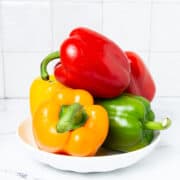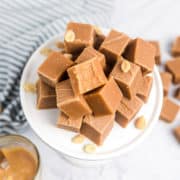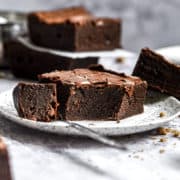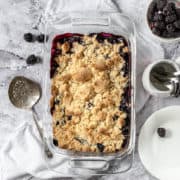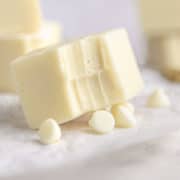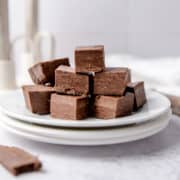Bell peppers are popular and they're widely available. Once you know how to store bell peppers so they keep for longer, you might want to make sure you don't run out of this crunchy vegetable which tastes good both raw and cooked.
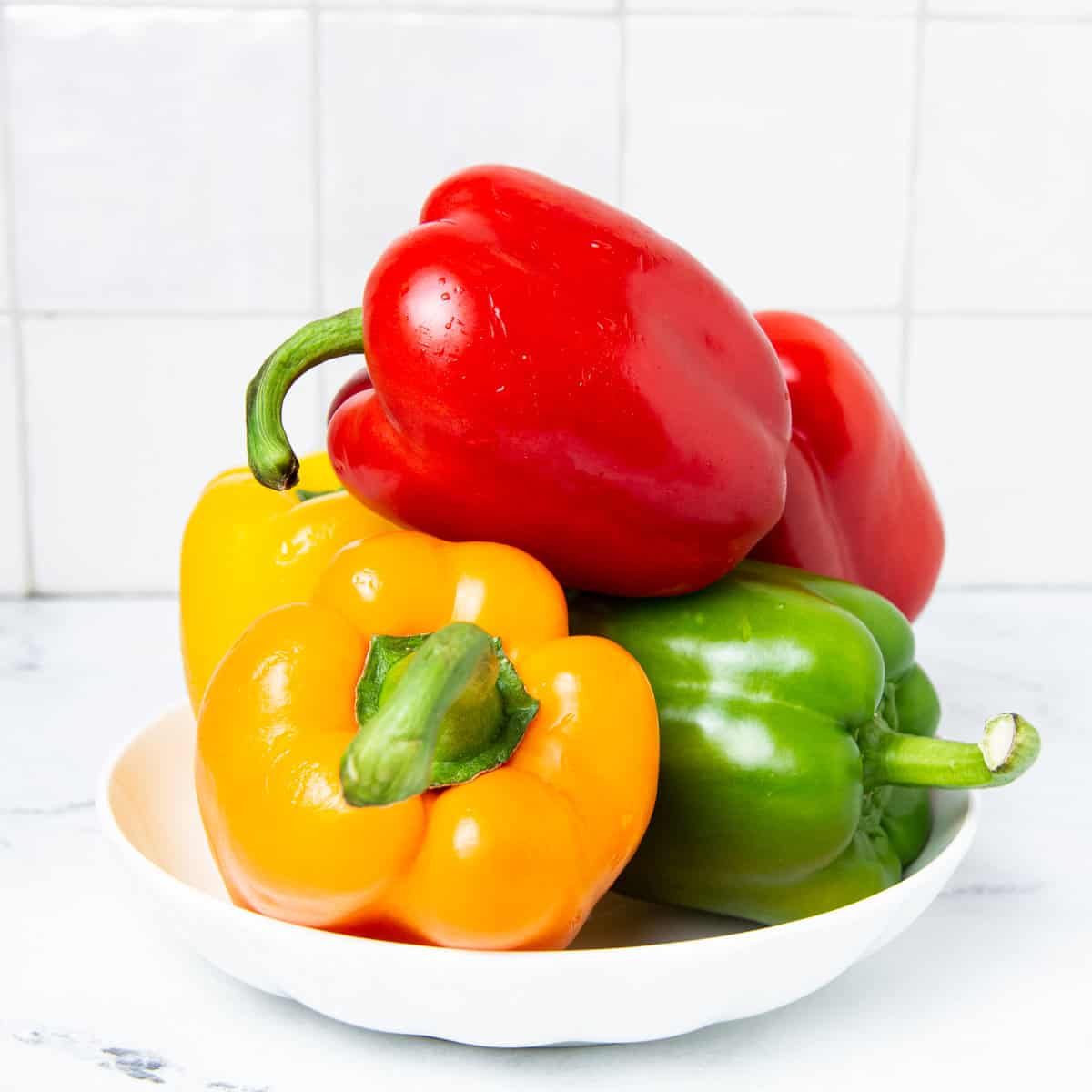
Jump to:
This versatile ingredient comes in a variety of colors and there are plenty of tasty bell pepper recipes to choose from. Add a pop of color to your next stir-fry, stew, salad, or chop and enjoy as a snack, perhaps with hummus or onion dip. If you want to eat them raw, it's a good idea to use the freshest peppers you can find, although slightly older ones will work in cooked recipes.
If you aren't keen on chilies or you want to reduce the heat of a dish, you can often simply sub bell peppers, for example when making egg puffs.
Stuffed bell peppers are a real family favorite around here, especially since there are so many fillings to consider, such as spiced ground beef, cheese, beans, and vegetables, or a grain such as rice or couscous mixed with your favorite sauce. Sometimes I'll assemble them ahead and then just bake them half an hour before dinner time.
What are Bell Peppers?
Bell peppers (Capsicum Annuum), also known as sweet peppers, are in the nightshade family. They are known as a vegetable but are botanically a fruit since the flesh grows around the seeded core. You can find them in just about any grocery store loose, bagged, or in plastic wrap.
In order of sweetness, the red ones are the sweetest, then there is orange then yellow, and finally green, the least sweet variety because it's the least ripe. And although they're a type of pepper, they don't have any spiciness you'd expect from chili peppers or hot peppers.
Bell peppers offer Vitamins A, B6, C, E, and K1, along with folate and potassium. They are great in all kinds of recipes from snacks and appetizers to salads, stir-fries, casseroles, and so on. There are so many delicious ways to enjoy them.
There are different varieties of bell peppers, such as lady bells which turn from green to red as they mature, purple bells which are purple when unripe and turn reddish black as they ripen, and then there is the chocolate bell which turns from green to brown as it ripens. Chocolate bell is a thinner-skinned bell pepper that goes soft soon after ripening, making it the trickiest to store.
How to Select Bell Peppers
The best quality, freshest bell peppers are bright and glossy with smooth, wrinkle-free skins. They should feel heavy for their size and be free from dark patches and bruises. The stem should be firm rather than soft or dried out. These are the easiest ways to tell whether raw bell peppers are fresh or beyond their prime.

How to Store Bell Peppers
Knowing how to store whole bell peppers means you can extend their shelf-life until you're ready to enjoy them. Read on to learn the best way to store bell peppers.
- Don't wash bell peppers before storing them, because excess moisture will speed up spoilage.
- Keep whole peppers in a produce bag or mesh bag or, if you don't have one, a plastic bag with some holes poked into it, since airflow helps extend the shelf life of fresh peppers.
- Store the bag of bell peppers in the crisper drawer of your fridge and use them within 2 weeks.
- You can also keep bell peppers in a cool, dry place at room temperature, but they probably won't last more than 2-3 days if it's warm in there.
- Don't keep them near fruits because they release ethylene gas, which can make vegetables spoil quicker.
- Keep chopped green bell peppers, red bell peppers, or whatever color you're using wrapped loosely in a paper towel and in mason jars or an airtight container in the refrigerator, and throw out any you haven't used within 3 days.
You can also freeze bell peppers as long as you chop or slice them before freezing and this is a great way to store them because they last so long in the freezer. Discard the seeds.
Spread the cut bell peppers in a single layer on a baking sheet or cookie sheet and freeze for an hour, then transfer them into a sealed container, resealable bag, or freezer bag to prevent freezer burn, squeezing out as much air as you can first.
You could use a vacuum sealer to remove excess air if you have one. Use frozen bell peppers within 12 months for the best results. You can toss frozen bell peppers directly into your recipe or let them thaw if you are going to eat them raw.
How to Tell if Bell Peppers are Spoiled
Leave any vegetable for enough time and it will begin to go bad. Signs of spoilage on bell peppers include softened, wrinkled skin. You can still cook bell peppers if those are the only issues. If you see mold, bruises, dark spots, or slime on your green peppers or whatever kind you're working with, throw them out.
Common Questions
The first thing to do is cut off ½ inch from the bottom of the pepper and another ½ inch from the stem end. Remove the core by running the knife around the flesh, then lay the pepper on its side and slice the skin side down into rings or strips. You can also dice it into whatever size pieces you want. Cut peppers can be cooked in a wide variety of ways and added to dishes like omelets, pilafs, stir-fries, and more.
Paprika is a smoky, earthy, sweet spice that's made from powdered, dried bell pepper. You can substitute smoked paprika or chipotle in most recipes.

Interesting Facts
- Red peppers have 6 times as much Vitamin A and more than twice as much Vitamin C than green ones.
- All bell peppers are from the same plant - their color (and flavor) depends on how long they were left to ripen before picking.
- China produces the most bell peppers followed by Mexico, Indonesia, Turkey, and then the United States.
Once you know how to store whole fresh bell peppers, you can expect them to last for days or even weeks. They are incredibly versatile and star in so many different recipes.
